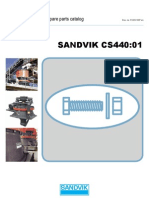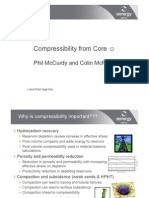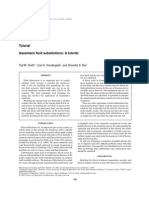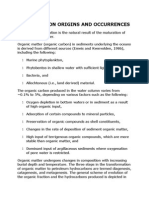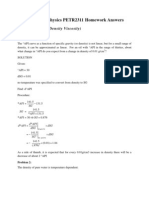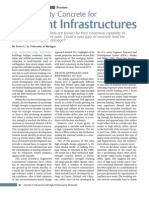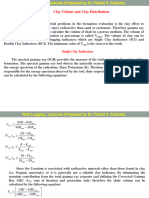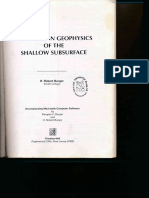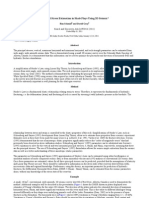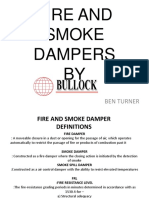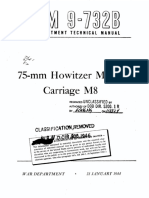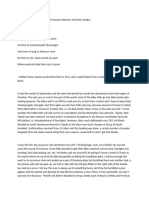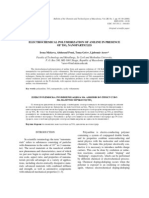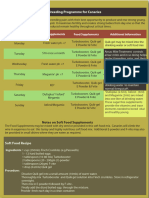Stresses Seismic Data
Stresses Seismic Data
Uploaded by
Ghulam Mohyuddin SohailCopyright:
Available Formats
Stresses Seismic Data
Stresses Seismic Data
Uploaded by
Ghulam Mohyuddin SohailCopyright
Available Formats
Share this document
Did you find this document useful?
Is this content inappropriate?
Copyright:
Available Formats
Stresses Seismic Data
Stresses Seismic Data
Uploaded by
Ghulam Mohyuddin SohailCopyright:
Available Formats
first break volume 30, March 2012 technical article
Estimation of stress and geomechanical
properties using 3D seismic data
David Gray,1* Paul Anderson,2 John Logel,3 Franck Delbecq,4 Darren Schmidt4 and Ron Schmid5
Abstract
Principal stresses, that is vertical, maximum horizontal and minimum horizontal stresses, and elastic moduli related to rock
brittleness, like Young’s modulus and Poisson’s ratio, can be estimated from wide-angle, wide-azimuth seismic data. This
is established using a small 3D seismic survey over the Colorado shale gas play of Alberta, Canada. It is shown that this
information can be used to optimize the placement and direction of horizontal wells and hydraulic fracture stimulations.
Introduction Closure pressure or closure stress is defined in the
In 2008, the lead author was asked to derive a method that Schlumberger Oilfield Glossary as ‘an analysis parameter used
would increase the relevance of seismic data in shale plays. in hydraulic fracture design to indicate the pressure at which
After a little research, it became apparent that geomechanical the fracture effectively closes without proppant in place’. In
parameters derived from seismic data could be very important general it is empirically related to the minimum horizontal
in shale plays. In most shale plays, and indeed in many other stress (e.g., Iverson, 1995). Expanding on Gray (2010b), a
plays, stimulation of the reservoir by hydraulic fracturing is the method for the estimation from seismic data of all three prin-
primary mechanism used to increase rates of oil and gas returns cipal stresses, the vertical stress, ıv, the maximum horizontal
to the surface. In ‘tight’ plays, such as shale gas, shale oil, and stress, ıH, and the minimum horizontal stress, ıh, is introduced
coal-bed methane, stimulation is required to make the wells eco- here.
nomically viable. Rickman et al. (2008) described four geome- Warpinski and Smith (1989) state that in-situ stresses
chanical considerations necessary for the design of a stimulation are clearly the most important factor controlling hydraulic
treatment. These are: brittleness, closure pressure, proppant size fracturing. Iverson (1995) shows that knowledge of shear
and volume, and the location of the initiation of the fracture. anisotropy allows for a reformulation of the closure stress
Seismic data allow for estimation of all of these values between equation to account for non-equal horizontal stresses,
existing wells except the proppant size and volume. which is generally the case in the earth’s crust, e.g., Bell et
The term ‘brittle’ is defined by the Oxford Dictionary as al. (1994). A simplification of Hooke’s law using linear slip
‘hard but liable to break easily’ and by Webster’s New World theory (Schoenberg and Sayers, 1995) allows the estimation
Dictionary as ‘easily broken or shattered’. Both of these defini- of principal stresses from wide-angle, wide-azimuth seismic
tions are appropriate for use in fracture stimulation, but are data (Gray, 2011). The rock properties required in its imple-
subjective. Although the term brittleness is used frequently in mentation are derived from wide-angle seismic data, e.g.,
tight plays, an objective definition was missing until Rickman Gray (2005a). The method is demonstrated by estimating the
et al. (2008) defined a relationship expressing brittleness as a principal stresses and rock properties for the Second White
percentage and related it to Young’s modulus and Poisson’s Speckled Shale using seismic data acquired in central Alberta,
ratio, which can both be derived from seismic data (e.g., Canada. The results show that only about one quarter of the
Mallick, 1995 for Poisson’s ratio; Gray, 2005a for Young’s Second White Speckled Shale in the survey area will fracture
modulus). In this paper, a generalized form of the Rickman as a network, while most of the rest will fracture linearly and
et al. (2008) percentage brittleness is estimated from Young’s some areas will not fracture at all, which implies that this
modulus and Poisson’s ratio, which are both derived from information can assist in the location of both wells and the
inversion of seismic data. optimal location to initiate fractures, which is the last of the
1
Nexen, 801 - 7th Avenue S.W., Calgary, Alberta, Canada, T2P 3P7.
2
Apache Energy, Level 9, 100 St Georges Terrace, Perth W. Australia, 6000.
3
Talisman Energy Norge, Verven 4, Sentrum, 4003 Stavanger, Norway.
4
Hampson-Russell, Suite 510, 715 - 5th Avenue SW, Calgary, Alberta, Canada, T2P 2X6.
5
CGGVeritas Canada Land Library, 715 - 5th Avenue S.W., #2200, Calgary, Alberta, Canada, T2P 5A2.
*
Corresponding author, E-mail: FDavid_Gray@nexeninc.com
© 2012 EAGE www.firstbreak.org 59
technical article first break volume 30, March 2012
Rickman et al. (2008) geomechanical parameters derivable say, the area of a seismic survey. This is because the seismic
from seismic data for this shale gas reservoir. response is calibrated to the well moduli through the process of
In order to calibrate the closure stress to actual measure- amplitude versus offset (AVO) inversion. AVO inversion using
ments taken in the field, an additional term, called the tectonic wide angles can also be used to estimate density from which
stress term, is often required to be added to the closure stress we can, in turn, calculate the vertical stress, ıv, through integra-
equation. Blanton and Olson (1999) state: ‘When independent tion. From ıv and the theory presented below, the minimum
measures of horizontal stress magnitudes are available from and maximum horizontal stresses, ıh and ıH, respectively, can
micro-fracs or extended leak-off tests, there is often a discrep- be estimated from wide-angle, 3D seismic data.
ancy between the log-derived and measured values, leading to If we assume that the rocks in-situ in the subsurface are
the conclusion that the uniaxial strain assumption inherent to constrained horizontally, i.e., the horizontal strain is zero in
[their] Eq. 1 is inadequate. In order to improve the estimated their natural state, and that the rocks are undergoing elastic
stress values, an adjustment (calibration) is made by adding an deformation, then we can estimate the in-situ stress state of
additional stress term to [their] Eq. 1, thereby shifting the profile these rocks from elastic information (Iverson, 1995). In fact,
to match the measured values.’ In this paper, the strain-corrected estimates of the three principal stresses can be obtained from
method of Blanton and Olson (1999) is used to calibrate the clo- anisotropic elastic parameters (Iverson, 1995). Since elastic
sure stress to known values. This method is adopted because it is information is derivable from seismic data via AVO inversion,
expected that strain will change smoothly across bedding planes, then the in-situ stress state can be estimated from anywhere
whereas horizontal stress can change rapidly from formation to where seismic waves have intersected the rocks at a wide
formation due to changes in elastic rock properties. (>40°) angle. Furthermore, the anisotropic stress equations of
Iversen (1995) can be recast using parameters from linear slip
Method theory (Schoenberg and Sayers, 1995), which can be derived
Seismic waves travelling through the earth create small, short- from wide-angle, wide-azimuth, 3D seismic data (e.g., Lefeuvre
term, strains in the rock that lie in the elastic regime of the et al., 1992; Varela et al., 2009), as shown here.
rocks. Therefore, using the assumptions outlined below, we are Using linear slip theory, Schoenberg and Sayers (1995)
able to calculate useful elastic moduli such as Young’s modulus showed that Hooke’s Law can be simplified to:
and Poisson’s ratio (Rickman et al., 2008) or the LMR (Lamé’s
modulus, shear modulus, and density) parameters of Goodway (1)
et al. (1997) (e.g., Gray, 2002). These moduli are described
as dynamic because they are measured by relatively high- where, İi are the strains in the rock, ıj are the stresses in the
frequency measurements of velocities of elastic waves (Fjaer, rock, and S represents the compliance of the rock. Linear
2009). These dynamic moduli measured by seismic and well slip theory simplifies the compliance terms by separating
logs occur in the high frequency range and with low strain it into two independent parts: Sb – the compliance of the
amplitudes (Olsen et al., 2004). background rock, and Sf – the compliance of the fractures
When the rock is subject to long-term strain in geotechnical and micro-fractures in the rock (Schoenberg and Sayers,
tests, such as in compressive failure tests used to judge the 1995). The incorporation of the concept of micro-fractures is
strength of rocks, static moduli are estimated from the slope important because it allows for the relationship of fractures
of the stress-strain relationship (Fjaer, 2009). Therefore, the to stress (e.g., Crampin, 1994), which is required for this
moduli related to hydraulic fracturing are most likely the formulation relating linear slip theory to the in-situ principal
static moduli, because hydraulic fracturing takes some time to stresses. It is assumed that the maximum horizontal stress is
build up the pressure required to fracture the rock. Olsen et parallel to a single set of parallel vertical fractures or micro-
al. (2004) suggested that the static modulus is a combination cracks and the minimum horizontal stress is perpendicular to
of the dynamic modulus and a non-elastic modulus related these fractures or micro-cracks (e.g., Schoenberg and Sayers,
to permanent deformation. The correction of the dynamic 1995). Expanding Equation (1) with linear slip theory leads
moduli to equivalent static moduli is often done via such a to the following system of equations:
method or by scaling (e.g., Fjaer, 2009). In addition, there can
be a frequency-dependent effect related to the pore size, the
squirt-flow mechanism described by Dvorkin and Nur (1993).
Seismic-derived dynamic moduli should indicate lateral
changes in elastic moduli and brittleness, which is related to (2)
them (Rickman et al., 2008) between wells. There are many
relationships between static and elastic moduli in the petro-
physical literature, suggesting that the best way to calibrate
them is by comparing local measurements of both. If such rela-
tionships can be determined, then they can be used to constrain
the extrapolation of static moduli away from wells within,
60 www.firstbreak.org © 2012 EAGE
first break volume 30, March 2012 technical article
where E is Young’s modulus, v is Poisson’s ratio, and μ is by assuming that the vertical stress is set equal to the overbur-
the shear modulus. The parameters ZN and ZT represent the den stress and horizontal strains are set to zero. Thus, the only
normal and tangential compliances, respectively. deformation allowed is uniaxial strain in the vertical direction.
Compliance is defined by the Merriam-Webster Dictionary When in-situ minimum horizontal stress measurements
as ‘the ability of an object to yield elastically when a force is such as micro-fracture(1) tests or extended leak-off tests are
applied’. In the case of linear slip theory, this definition should available, there is often a discrepancy between the log-derived
be applied to both the background material and the faces of values (and therefore, seismic-derived values, since they are
fractures, i.e., it is the ability of the background material and/ based on inversions to match log properties) and these meas-
or a fracture in it to yield elastically when a force is applied. ured values, leading to the conclusion that the uniaxial strain
The normal strain component perpendicular to a fracture or assumption inherent is inadequate. In order to improve the
a plane of weakness in the material is related to the material’s estimated stress values, the stress is shifted by adding an
normal compliance, ZN. Shear strain components tangential to additional ‘tectonic stress’ term to the equation to match the
a fracture or a plane of weakness in the material are related to measured values (Blanton and Olson, 1999). Rather than
the material’s tangential compliance, ZT. adding a tectonic stress term, we use the tectonic strain method
Making the assumption that one principal stress is vertical, described by Blanton and Olsen (1999) to estimate a vertically
so the other two are horizontal, Equation (2) may be used variable shift in stress. The primary rationale for using tectonic
to write the horizontal strains as functions of these stresses. strain rather than tectonic stress is that the horizontal strains
Given the assumption that the rocks, in-situ, are constrained are expected to be more continuous than the horizontal stress-
horizontally, these horizontal strains are equal to zero: es. This can be conceptualized through the realization, from
Equations (5) and (6), that the horizontal stresses are functions
(3) of the continuous vertical stress multiplied by a function of the
discontinuous parameters, E, v, and ZN. Then again, the fact
and that this calibration needs to be done implies that the rocks in
question are undergoing horizontal strain, thereby revising our
(4) earlier assumption that the rocks are horizontally constrained.
Nevertheless, this strain can be captured in the above equations
Solving Equations (3) and (4) for the principal horizontal by incorporating the tectonic strain term of Blanton and Olsen
stresses yields the following equations: (1999). Thereafter, at the well, the horizontal stresses are
calibrated to the well measurements and can then be used as
(5) estimates of inter-well stresses and, therefore, for well planning.
It turns out that a differential horizontal stress ratio
and (DHSR), i.e., the differential ratio of the maximum and
minimum horizontal stresses as shown in Equation (7), can
(6) be calculated from seismic parameters derived from these
equations alone, without any knowledge of the stress state of
All of the parameters in Equations (5) and (6) can be derived the reservoir, because ıv in Equations (1) and (2) cancels when
from seismic data (e.g., Mallick, 1995 for v; Gray, 2005a for calculating it:
E). Downton and Roure (2010) use modern wide-angle, 3D,
seismic data to estimate ZN. The vertical stress is generally (7)
estimated by integrating logged density over depth and mul-
tiplying by the acceleration due to gravity. As density can be DHSR is a very important parameter in determining how a res-
estimated from seismic data (e.g., Van Koughnet et al., 2003), ervoir is likely to fracture. In general, in hydraulic fracturing, it
the vertical stress can also be estimated integrating the density is preferable if it is small. When the DHSR is large, hydraulic
estimated from seismic data. This means that the anisotropic fractures will tend to occur as non-intersecting planes parallel
in-situ stress state of the rock and its elastic moduli and brittle- to the maximum horizontal stress, since fractures tend to be
ness can be estimated between wells through the use of modern created parallel to it. In contrast, when the DHSR is small,
3D seismic data. fractures induced by hydraulic fracturing will tend to grow
Since we know how to derive all these parameters from in a variety of directions and therefore intersect. This multi-
seismic data, we can also estimate all three principal stresses directional fracture network tends to provide much better
from seismic data. These stresses need to be calibrated to access to the hydrocarbons in the reservoir.
static stress measurements obtained from wells, and when this The knowledge of elastic parameters, such as Young’s
is done it is found that the horizontal stresses are frequently modulus or the shear modulus, indicates which rocks are brit-
underestimated. Fortunately, the concept of tectonic stress has tle and therefore likely to fail. Rickman et al. (2008) derived a
already been introduced in the engineering world to deal with means of estimating brittleness, B, from logs. Equation (8) is a
this discrepancy. The formula for solving for stress is obtained generalized form of these equations. Brittleness is expressed
© 2012 EAGE www.firstbreak.org 61
technical article first break volume 30, March 2012
as a percentage. These same equations can be applied to the Knowledge of the stress state prior to drilling can also
inversion results because they are tied to these same logs: be used to predict areas at risk for wellbore failure, thereby
allowing for bypassing of these areas or preparation for the
(8a) drilling problems likely to be encountered therein. For example,
note that any of the formation breakdown pressures could be
(8b) negative, then the formation will likely fracture solely due to the
presence of the borehole. It is important to know this possibility
and before drilling because there is a risk of lost circulation in that
borehole. This scenario does occur and is shown in the example
(8c) below. The hoop stress can also be significantly higher than
the closure stress. Therefore, it is important to be aware of this
where BE is brittleness estimated from Young’s modulus, Bn is prior to attempting to initiate hydraulic fracture. Wide-angle,
brittleness estimated from Poisson’s ratio and subscripts min wide-azimuth, 3D conventional P-wave, or multi-component
and max denote minimum and maximum values. seismic data allow the estimation of these parameters before
In order to determine how these rocks will fracture under wells are drilled. For conventional seismic data, azimuthal
the stresses induced by hydraulic fracturing, knowledge of all inversion is used. For multi-component seismic data, birefrin-
these parameters is important. To fracture the rock, the pres- gence, registration, and inversion can be used. These parameters
sure in the well must first overcome the hoop stress created in must be calibrated to known points of stress and elastic moduli
the rocks around the borehole. Then it must be greater than within the reservoir. Then, using this additional knowledge, bet-
the far-field stresses away from the borehole in order to con- ter well planning should be achievable in order to optimize well
tinue its growth. The hoop stress and far-field stresses may be location, direction and location of hydraulic fractures. How this
similar, but the possibility exists that they can be completely might be done is demonstrated in the following example.
different from each other in both maximum stress direction
and magnitude. In the example below, the hoop stress is about Example
twice the far-field stress, so knowledge of both is critical. Such A small, 9 km2, conventional P-wave, wide-azimuth, 3D
differences can have a significant impact on wellbore design. seismic survey shot southeast of Red Deer, Alberta, Canada
The hoop stress is the additional tangential stress in the in the Western Canadian Sedimentary Basin (WCSB) is used
rock close to the borehole wall that is induced by the presence to demonstrate the method. The target area is the Cretaceous
of the borehole. It can be estimated once the principal stresses Colorado Shale Group, highlighted by a dashed box in the
are known. Since it has been shown above that the principal figures, which sits above weak shales of the Joli Fou Formation
stresses can be estimated from seismic data, the hoop stress and sandier Lower Cretaceous Mannville Formation. The
can also be estimated. The hoop stress, ıșș, at the borehole Mannville Formation sits above an unconformity, below which
wall for three cases is considered here. For a vertical borehole, the strata consist predominantly of carbonate rocks. It will be
the minimum hoop stress is oriented parallel to ıh and is given shown that the Second White Speckled Shale unit is the most
by brittle part of the Colorado Shale Group and will be the focus
of this example. Figure 1 shows the DHSR as plates displayed
(9) over estimates of Young’s modulus for the entire 3D volume.
The direction of the plates indicates the estimated direction of
For the top of a horizontal borehole oriented perpendicular to ıH, and their size, the magnitude of DHSR (Figure 2). These
ıH, with ıv > ıH, show significant variations over this very small area, largely
driven by ıh (Figures 3 and 4).
(10) Estimates of the principal stresses are derived as described
above and calibrated to stress estimates for the whole WCSB
For the side of a horizontal borehole oriented perpendicular to available from the WCSB Atlas (Bell et al., 1994) using the
ıH, with ıH > ıv, tectonic strain concept of Blanton and Olsen (1999). Local
calibration is preferred, but no wells with stress estimates in the
(11) Colorado Shale Group are available in this area. For example,
subsequent stress estimation projects performed by the authors
The general case was given by Kirsch (1898). Following Lund have used information derived from local well-based closure
(2000) and in the example below, it is assumed that the differ- stress estimates to calibrate the minimum horizontal stresses.
ence, ΔP, between the fluid pressure in the borehole and the Figures 3 and 4 show significant vertical and horizontal
formation pore pressure is zero. It is necessary to overcome variations in ıh. Very low values are associated with Mannville
the hoop stress in order to initiate a fracture in the formation; Formation coals and the weak shales of the Joli Fou Formation.
therefore, these stresses can be considered as the formation High values are associated with carbonates in the bottom of the
breakdown pressure, PFB. figures below the unconformity.
62 www.firstbreak.org © 2012 EAGE
first break volume 30, March 2012 technical article
Figure 1 Dynamic Young’s modulus from the 3D seismic volume shown in colour, with the scale numbered in units of GPa. Plates, indicated by the arrow, show
the differential horizontal stress ratio (DHSR). The size of the plate is proportional to the magnitude of the DHSR and the direction of the plate shows the
direction of the local maximum horizontal stress. The long axis of the survey is E-W and survey area is 9 km2.
Figure 2 Maximum horizontal stress, ıH , showing the target Colorado Shale and the Second White Speckled Shale (2WS) formation within it. The coloured stripes
at the well locations are the vertical stress, ıv , for reference.
These variations are probably due to different litholo- estimated using the generalization of the approach of Rickman
gies being stressed differently as they drape over underlying et al. (2008), described above, combining Young’s modulus and
pinnacle reefs of the Leduc Formation (Gray, 2005b), dif- Poisson’s ratio as shown for these data in Figure 5. Furthermore,
ferential compaction stresses, stresses induced by underlying there are significant variations in the DHSR ranging from
salt collapse, or stresses due to the presence of open fractures zero to over 100% (Figure 6). Both of these parameters have
in this formation. The horizontal slice in Figure 1 shows 100% significant impact on whether and how the rock will fracture:
variations in Young’s modulus ranging from 12–24 MPa. higher values of brittleness indicate rocks that are more likely
Variations in Young’s modulus and Poisson’s ratio should be to fracture and lower values of the DHSR indicate areas where
expected due to variations in lithology, porosity, fluid content, rocks will have a greater tendency to fracture into a network.
fractures and cement in any sedimentary rock. Brittleness is Clearly, we want to find areas where both these properties
© 2012 EAGE www.firstbreak.org 63
technical article first break volume 30, March 2012
Figure 3 Minimum horizontal stress, ıh , showing the target Colorado Shale and the Second White Speckled Shale (2WS) formation within it. The coloured stripes
at the well locations are the vertical stress, ıv , for reference.
Figure 4 Map of minimum horizontal stress, ıh, over the Second White Speckled Shale. Note its variability over a short distance from about 20 MPa around
well 14-13 to 26 MPa around well 6-13. North is to the top and east to the right. The red line towards the top of the figure shows the location of the sections
shown in other figures. After Gray 2010a.
occur in order to find the best areas for hydraulic fracturing. zone in the middle of Figure 7, should be drilled first, which
Young’s modulus is used as a proxy for brittleness throughout should move the best production forward, thereby increasing
the remainder of this study. net present value.
This requirement for high brittleness and low DHSR It is significant that there are such large differences in the
suggests that a crossplot of these values should indicate areas properties that are important for hydraulic fracturing over very
that are suitable for the creation of fracture networks. Figure 6 short distances. Examination of the variations to the southwest
is a demonstration of such a crossplot using the seismic data of Well 14-13 in the north-central part of Figures 7 and 4 show
for the Colorado Shale Group, which consist primarily of a change from a very good area for hydraulic fracturing to a
Late Cretaceous shales. The result of applying this crossplot to bad area over a distance of less than 200 m, much shorter than
the Second White Speckled Shale Formation of the Colorado the length of most horizontal wells drilled in these plays. The
Group is shown in Figure 7. The zones and cut-offs in the results indicate that most of the Second White Speckled Shale
crossplot should be optimized through well control as the field will fracture with parallel fractures, implying that it will be very
is developed. Areas where the DHSR is small and Young’s important to direct the horizontal wells intended to be fractured
modulus is large (green in Figure 7) are confined to small areas as nearly parallel to the average ıh direction as possible.
of this already small survey. These areas, such as the green Therefore, knowledge of the rapid variation in the direction of
64 www.firstbreak.org © 2012 EAGE
first break volume 30, March 2012 technical article
Figure 5 Brittleness in percent, estimated using our generalization of the methods of Rickman et al. (2008). The green stripes at the well locations are there
because there is no equivalent brittleness log in the project.
Figure 6 Crossplot of DHSR versus Young’s
modulus. Preferred areas for hydraulic fractur-
ing are indicated in green, less desirable areas
in yellow, and poor areas in red.
Figure 7 Map of Second White Speckled Shale showing zones highlighted in the crossplot in Figure 6. Green suggests where fracture swarms will form, red sug-
gests the rocks are more ductile and thus less likely to fracture, and yellow suggests where aligned fractures are likely to occur. There are considerable variations
in the north-central part of the survey, where the data suggest areas good and bad for hydraulic fracturing within about 100 m of each other.
© 2012 EAGE www.firstbreak.org 65
technical article first break volume 30, March 2012
ıh, or ıH, as shown in Figure 1, is important information for
optimal hydraulic fracturing of this reservoir. This rapid varia-
tion in the stress direction is consistent with the interpretation
of the causes of fracture orientation in underlying coalbeds and
sandstones described by Gray (2005b). He ascribed these frac-
tures to local stress induced by drape over underlying pinnacle
reefs and differences in brittleness due to lithology. They could
also be caused by differential compaction or collapse associated
with underlying salt dissolution.
Areas indicated in red in Figure 7 have a low likelihood
of fracturing and therefore should be assessed carefully before
drilling. There will likely be difficulty fracturing these rocks. Figure 8 The hoop stress concept: ‘If a circular hole is made in a homogeneous
However, one possible reason for the low level of brittleness is body experiencing a homogeneous stress field, stress will concentrate around
the hole since no force can be carried through the interior void. [This] Figure
high total organic carbon content, which is potentially beneficial … shows the stress concentration around the hole in a body under uniaxial
to production. This reason is just one example of why all levels compression, of magnitude ı1R in the far-field, in the x-direction’ (Lund, 2000).
of brittleness should be properly assessed before proceeding
with drilling, which can only be done with seismic data. Assume Kirsch’s (1898) concept of hoop stress (Figure 8) can be
that one well per square kilometre is required to develop this used to estimate PFB given the principal stresses that have been
shale gas play with drilling and completion costs of US$8 mil- estimated already. Hoop stress is generated by the removal of a
lion per well, which are similar to numbers that are commonly cylinder of material caused by the drilling of a well. By estimat-
reported (e.g., Crum, 2008), and assume that the areas in red ing hoop stresses from the principal stresses derived earlier, we
in Figure 7 will not fracture. This study shows that only three- can get an idea of what will happen while drilling before a well
quarters of the prospect will fracture, meaning that two of the is drilled. Here we assume that the pressure in the borehole is
nine wells should not be drilled. The cost saving, by not drilling close to the formation pressure in this estimation (although if
the two wells, would be $16 million, reducing the total cost to wellbore pressures, e.g. mudweights, are known then they can
develop this 9 km2 area from $72 million to $56 million. These be used). Since from the above analysis we now have estimates
savings easily pay for the acquisition, processing, and analysis of principal stresses everywhere, we can see what will happen
of the seismic data used to derive this information, and are in everywhere before a well is drilled and thereby avoid areas
addition to the uplift in net present value derived by drilling and where there are potential wellbore stability issues.
completing the best areas first and additional value of deriving In Figure 9, we can see that there are potential vertical
field scale development plans (e.g., orientation of horizontal wellbore stability issues (green zones indicating very low PFB)
wells on a large scale for optimum pad placement and planning). in vertical wells in the Mannville coalbeds (below the Colorado
Figure 9 Fracture breakdown pressure (PFB ) at the side of a vertical borehole. Areas shown in green indicate areas of very low or negative PFB indicating a sig-
nificant risk of borehole failure at these locations. Many of these are in the Mannville coals at about 1000 ms, which is not surprising, but there are also some
in the primarily carbonate section under the unconformity marked by the blue line at about 1075 ms. This information has potential importance for drilling.
The coloured stripes at the well locations are the vertical stress, ıv , for reference. After Gray 2010a.
66 www.firstbreak.org © 2012 EAGE
first break volume 30, March 2012 technical article
Figure 10 PFB at the side of a horizontal borehole. Lower values indicate where it is easier to initiate fractures from the side of the borehole. Values ranging
from about 20 MPa to over 100 MPa show that it is important this information be considered in well planning. The target Second White Speckled Shale (2WS)
Formation has moderate PFB of 40-50 MPa, which is significantly greater than its closure stress, indicating that a significant amount of force will be required to
initiate the fracture at the borehole, but that once the fracture is initiated, then it should continue to propagate until the pressure drops below the closure
pressure of 20-50 MPa. The coloured stripes at the well locations are the vertical stress, ıv, for reference. After Gray (2010a).
Figure 11 Difference of fracture breakdown pressure for a horizontal well, PFB(side) – PFB(top). Positive values mean that the fracture will initiate out of the sides
of a horizontal borehole. Negative values mean that fractures will initiate from the top of the borehole.
Shale), which are expected, and in the carbonate section below Discussion
the unconformity at the base of the Mannville section, which It has been demonstrated that seismic data can be used to
is unexpected. We can also drill wells in areas where the hoop estimate rock brittleness and stresses away from boreholes.
stress is in a range such that the pressure generated in the well- The combination of these estimates allows for assessment of
bore during drilling is lower and the pressure generated during the potential for hydraulic fractures and geomechanical issues
hydraulic fracturing is sufficient to overcome it and break the in boreholes before drilling any wells. An example from the
rock without damaging the casing. Since horizontal wellbores Colorado Shale of Alberta is used to demonstrate the method.
will be drilled here, we should examine the fracture breakdown This method is based on physics and so is applicable in any shale
pressure for a horizontal wellbore (Figure 10) before drilling. gas play as well as any other play where hydraulic fracturing is
We can also estimate whether the fracture will initiate in the being considered, such as tight gas sands, coalbed methane, and
top of the borehole or on its side (Figure 11). The closure stress carbonates, and where stress or geomechanics are at issue, such
and rock properties, derived earlier, predict how the fracture as in heavy oil plays and new exploration. The seismic data
will behave away from the borehole. should be used to extrapolate information derived at wellbores
© 2012 EAGE www.firstbreak.org 67
technical article first break volume 30, March 2012
to the inter-well regions. However, this analysis can be done Goodway, W., Chen, T. and Downton, J. [1997] Improved AVO fluid
without well information using measured seismic velocities and detection and lithology discrimination using Lamé petrophysical
assumed petrophysical relationships. Once principal stresses are parameters; ‘Ȝȡ’,’μȡ’, & ‘Ȝ/μ fluid stack’, from P and S inversions. 67th
estimated, other useful stress estimates, such as hoop stress, can SEG Annual Meeting, Expanded Abstracts, 16, 183–186.
be used to predict how the well will behave while drilling and Gray, D. [2002] Elastic inversion for Lamé parameters, 72nd SEG Annual
under stimulation. Meeting, Expanded Abstracts, 21, 213–216.
Gray, D. [2005a] Estimating compressibility from seismic data. 67th EAGE
Conclusions Conference & Exhibition, Extended Abstracts, P025.
There is a tremendous amount of information on stresses and Gray, D. [2005b] Seismic anisotropy in coal beds. 75th SEG Annual
rock properties that can be estimated from wide-angle, wide- Meeting, Expanded Abstracts, 24, 142–45.
azimuth, 3D seismic data. The horizontal stresses derived from Gray, D. [2010a] Targeting horizontal stresses and optimal hydraulic
this method need to be calibrated to stress values estimated fracture locations through seismic data. 6th Annual Canadian Institute
from well data. Once this is done, these stresses can be used to Shale Gas Conference. http://www.cggveritas.com/technicalDocu-
estimate various stresses likely to be encountered between wells. ments/cggv_0000006453.pdf
Furthermore, the elastic properties derived during this process, Gray, D., Anderson, P., Logel, J., Delbecq, F. and Schmidt, D. [2010b]
such as shear modulus, Young’s modulus, and Poisson’s ratio, Estimating in-situ, anisotropic, principal stresses from 3D seismic. 72nd
which also require static moduli for calibration, can be used to EAGE Conference & Exhibition, Extended Abstracts, J046.
estimate the brittleness of the rock between wells. This informa- Gray, F.D. [2011] Methods and systems for estimating stress using seismic data.
tion can then be used to plan well paths and optimize hydraulic United States Patent Application, 20110182144A1. http://www.google.
fracture programmes. com/patents/US20110182144.pdf?source=gbs_overview_r&cad=0.
Iverson, W.P. [1995] Closure stress calculations in anisotropic formations.
Acknowledgements SPE 29598.
We thank CGGVeritas, EnCana, Apache, Talisman Energy, Kirsch, G. [1898] Die Theorie der Elastizität und die Bedürfnisse der
Magnitude, Fairborne Energy, Nexen, Bill Goodway, Doug Festigkeitslehre. Zeitschrift des Vereines deutscher Ingenieure, 42,
Anderson, Ron Larson, Jonathan Miller, Louis Chabot, Eric 797–807.
Andersen, Jared Atkinson, John Varsek, Tobin Marchand, Lefeuvre, F., Nicoletis, L., Ansel, V. and Cliet, C. [1992] Detection and
Dominique Holy, Colin Wright, Wayne Nowry, Jessie Arthur, measure of the shear-wave birefringence from vertical seismic data:
Philip Janse, Christophe Maison, Dragana Todorovic-Marinic, theory and applications. Geophysics, 57, 1463–1481.
Christian Abaco, Lee Hunt, Scott Reynolds and Jon Downton. Lund, B. [2000] Stress around a borehole. http://www.geofys.uu.se/bl/Avh/
node8.html
Note Mallick, S. [1995] Model-based inversion of amplitude-variations-with-
(1)
A short duration, small volume fracturing operations offset data using a genetic algorithm. Geophysics, 60, 939–954.
where a small amount (<100 BBLS) of KCL water is Olsen, C., Fabricius, I.L., Krogsbøll, A. and Prasad, M. [2004] Static
pumped until fracture initiation. At that point the wing and dynamic Young’s Modulus for Lower Cretaceous chalk. A low
or frac valve is closed allowing the well’s pressure to fall- frequency scenario. AAPG International Meeting, Extended Abstracts,
off naturally over the course of 24 to 48 hrs. (or longer). 89511.
Rickman, R., Mullen, M., Petre, E., Grieser, B. and Kundert, D. [2008] A
References practical use of shale petrophysics for stimulation design optimization:
Bell, J.S., Price, P.R. and McLellan, P.J. [1994] In-situ stress in the all shale plays are not clones of the Barnett Shale. SPE 115258.
Western Canada Sedimentary Basin. In: Mossop, G.D. and Shetsen, Schoenberg, M. and Sayers, C.M. [1995] Seismic anisotropy of fractured
I. (Compilers) Geological Atlas of the Western Canada Sedimentary rock. Geophysics, 60, 204-211.
Basin, Canadian Society of Petroleum Geologists and Alberta Research Van Koughnet, R.W., Skidmore, C.M., Kelly, M.C. and Lindsay, R.O.
Council, Special Report 4. http://www.ags.gov.ab.ca/publications/ [2003] Prospecting with the density cube. The Leading Edge, 22,
wcsb_atlas/atlas.html 1038–1045.
Blanton, T.L. and Olsen, J.E. [1999] Stress magnitudes from logs: effects of Varela, I., Maultzsch, S., Chapman, M. and Li, X. [2009] Fracture density
tectonic strains and temperature. SPE 54653. inversion from a physical geological model using azimuthal AVO
Crampin, S. [1994] The fracture criticality of crustal rocks. Geophysical with optimal basis functions. 79th SEG Annual Meeting, Expanded
Journal International, 118, 428–438. Abstracts, 28, 2075–2079.
Crum, J. [2008] 2008 Analyst Review, Apache Corporation, Canada. Warpinski, N.R. and Smith, M.B. [1989] Rock mechanics and fracture
http://www.apachecorp.com/resources/upload/prevarticlefiles/files/ geometry in recent advances in hydraulic fracturing. In: Gidley, J.L.
apache_2008_analyst_review_08_canada.pdf (Ed.) Recent Advances in Hydraulic Fracturing. SPE, Monograph 12,
Dvorkin, J., Hoeksema, R.N. and Nur, A. [1994] The squirt-flow mecha- 57–80.
nism: macroscopic description. Geophysics, 59, 428–438.
Fjær, E. [2009] Static and dynamic moduli of a weak sandstone. Geophysics, Received 24 January 2011; accepted 10 January 2012.
74, WA103–WA112. doi: 10.3997/1365-2397.2011042
68 www.firstbreak.org © 2012 EAGE
You might also like
- CS440-01 R223.1337en Spare Parts CatalogDocument32 pagesCS440-01 R223.1337en Spare Parts CatalogLuis Aguilera S92% (13)
- RE1 HW6 Fractional Flow Bissembay SholpanDocument11 pagesRE1 HW6 Fractional Flow Bissembay SholpanШолпан Бисембай100% (1)
- ResGeo202MOOC HW3-Solutions FinalDocument3 pagesResGeo202MOOC HW3-Solutions Finalpande_100No ratings yet
- Spe 99668 MSDocument14 pagesSpe 99668 MSCamilo Andrés GuerreroNo ratings yet
- Compressibility From CoreDocument18 pagesCompressibility From CoreginozkyNo ratings yet
- Modeling The Effects of Glauconite On Some Openhole Logs From The Lower Senonian in EgyptDocument22 pagesModeling The Effects of Glauconite On Some Openhole Logs From The Lower Senonian in EgyptAlejandro Parra RojasNo ratings yet
- Biblical Speech On Teacher Day 2019Document2 pagesBiblical Speech On Teacher Day 2019Kalyan Sarkar75% (4)
- Ciz Shapiro Fluid Solid SubstitutionDocument5 pagesCiz Shapiro Fluid Solid SubstitutionGlusmNo ratings yet
- Novel Pore Pressure Prediction Technique For Unconventional ReservoirsDocument19 pagesNovel Pore Pressure Prediction Technique For Unconventional Reservoirssergioandresar01100% (1)
- Fdflow A Fortran 77 Solver For 2d Incomp FlowDocument27 pagesFdflow A Fortran 77 Solver For 2d Incomp FlowYosua Heru IrawanNo ratings yet
- The Similarities and The Differences Between Geomagnetic and Gravity SurveyDocument2 pagesThe Similarities and The Differences Between Geomagnetic and Gravity SurveyTri Wulaningsih100% (2)
- Constrained Rock Physics Modeling: SPECIALSECTION: Rock Physics Rock Physics SPECIALSECTION: Rock PhysicsDocument5 pagesConstrained Rock Physics Modeling: SPECIALSECTION: Rock Physics Rock Physics SPECIALSECTION: Rock PhysicsIftikhar Satti100% (1)
- Waxman Smiths EquationDocument17 pagesWaxman Smiths EquationNikolay Moor100% (1)
- Utilization of Dimensionless Variables in Well TestingDocument36 pagesUtilization of Dimensionless Variables in Well TestingHrishikesh ChavanNo ratings yet
- Coffey Insight Geomechanics of Hydraulic Fracturing Michael BlackamDocument17 pagesCoffey Insight Geomechanics of Hydraulic Fracturing Michael BlackamYoggie Surya PradanaNo ratings yet
- "Seismic Data To Estimate Formation Pressure": University of Karbala College of Engineering Petroleum Eng. DepDocument12 pages"Seismic Data To Estimate Formation Pressure": University of Karbala College of Engineering Petroleum Eng. DepAli MahmoudNo ratings yet
- Extended Elastic Impedance and Its Relation To AVO Crossplotting and VpVsDocument5 pagesExtended Elastic Impedance and Its Relation To AVO Crossplotting and VpVsMahmoud EloribiNo ratings yet
- ResGeo202MOOC HW3Document1 pageResGeo202MOOC HW3Muhammad HanifNo ratings yet
- Sis Global Forum 2014 AbstractsDocument223 pagesSis Global Forum 2014 AbstractsArmandoEsquivelNo ratings yet
- 1.11 Fracture GradientsDocument36 pages1.11 Fracture Gradientskhaldimh555No ratings yet
- Angelier 1990Document14 pagesAngelier 1990Javier Roberto De AndaNo ratings yet
- Reservoir CharacterizationDocument5 pagesReservoir CharacterizationNGuyen Manh HungNo ratings yet
- Dual Water ModelDocument22 pagesDual Water ModelpahlawankemalemanNo ratings yet
- Homework Assignment Well LoggingDocument10 pagesHomework Assignment Well Loggingkpratik41100% (1)
- Gassman TutorialDocument11 pagesGassman TutorialKristian TorresNo ratings yet
- Petrophjysics To Well LogDocument4 pagesPetrophjysics To Well LogSando CrisiasaNo ratings yet
- Understanding The Resistivities Observed in Geothermal SystemsDocument6 pagesUnderstanding The Resistivities Observed in Geothermal SystemsothmansaeedNo ratings yet
- SPE-197352-MS Integrated Reservoir Characterisation of An Emerging Unconventional Resource Play in The UAEDocument21 pagesSPE-197352-MS Integrated Reservoir Characterisation of An Emerging Unconventional Resource Play in The UAEzachNo ratings yet
- Co2 StorageDocument11 pagesCo2 Storagesaifulislam9442No ratings yet
- GeoRock - ServicesDocument17 pagesGeoRock - Servicesوجدي بلخيريةNo ratings yet
- Hydraulic Flow Units: A Bayesian ApproachDocument12 pagesHydraulic Flow Units: A Bayesian ApproachADWINDT100% (4)
- Hydrocarbon Origins and OccurrencesDocument22 pagesHydrocarbon Origins and OccurrencesTri Haryanta100% (1)
- Briefing N°8 - Chaperon-Method-in-Coning-at-Horizontal-Oil-WellsDocument4 pagesBriefing N°8 - Chaperon-Method-in-Coning-at-Horizontal-Oil-WellsANDREW LOJANo ratings yet
- Ordovician Tight ReservoirDocument12 pagesOrdovician Tight ReservoirAHMEDNo ratings yet
- Lesson 3 Homework Solutions - Density ViscosityDocument11 pagesLesson 3 Homework Solutions - Density ViscosityMark Moran0% (1)
- SPWLA Paper AshokKUmarDocument12 pagesSPWLA Paper AshokKUmarKilaparthi SatyavammaNo ratings yet
- High Ductility ConcreteDocument6 pagesHigh Ductility ConcreteKurniawan PittaNo ratings yet
- NDX SantanaDocument5 pagesNDX SantanaAz RexNo ratings yet
- Spe 10022Document17 pagesSpe 10022Jorge Carmona100% (1)
- L 02 Darcy Linear Radial PDFDocument8 pagesL 02 Darcy Linear Radial PDFananthgeoNo ratings yet
- GP208 HW1 State of Stress Solutions PDFDocument6 pagesGP208 HW1 State of Stress Solutions PDFSofiaNo ratings yet
- Subsidence and Thermal HistoryDocument28 pagesSubsidence and Thermal Historyalbert mwairwa100% (1)
- 10 1306@ PDFDocument38 pages10 1306@ PDFc_b_umashankarNo ratings yet
- Saturated Oil-Gas Simulation - Impes Solution: o Os GS So oDocument11 pagesSaturated Oil-Gas Simulation - Impes Solution: o Os GS So onaefmubarakNo ratings yet
- Two Phase Flow Hagerdown & BrownDocument27 pagesTwo Phase Flow Hagerdown & BrownJonathan GuanoNo ratings yet
- Iptc 17429 MSDocument18 pagesIptc 17429 MSPOOL SERVICES & SUPLLIESNo ratings yet
- Rock Mass Properties For Underground MinesDocument21 pagesRock Mass Properties For Underground Minesrobbyon100% (1)
- Dr. Fadhil Lucture3Document17 pagesDr. Fadhil Lucture3ckcp7sy2ztNo ratings yet
- Permian (Upper Rotliegend Synsedimentary Tectonics, Basin Development and Palaeog - S - North SeaDocument32 pagesPermian (Upper Rotliegend Synsedimentary Tectonics, Basin Development and Palaeog - S - North SeaGizal Andika DharmawanNo ratings yet
- 11.108 - Static Models ReportsDocument153 pages11.108 - Static Models Reportsskywalk189100% (1)
- 02 Sonic Investigations PDFDocument20 pages02 Sonic Investigations PDFSuyash KumarNo ratings yet
- Advanced Gas Material Balance in Simplified Format: S. Moghadam, O. Jeje, and L. Mattar, Fekete Associates IncDocument9 pagesAdvanced Gas Material Balance in Simplified Format: S. Moghadam, O. Jeje, and L. Mattar, Fekete Associates IncAmr HegazyNo ratings yet
- Aspects of Rock Phys PDFDocument32 pagesAspects of Rock Phys PDFDaniel RubénNo ratings yet
- Seismic Response Seismic Response: What Causes A Seismic Response? What Causes A Seismic Response?Document11 pagesSeismic Response Seismic Response: What Causes A Seismic Response? What Causes A Seismic Response?Julian I SwandiNo ratings yet
- Marine and Petroleum Geology: Research PaperDocument12 pagesMarine and Petroleum Geology: Research PaperericconchamunozNo ratings yet
- CH-4 Log Correlation Techniques 22 48-1-10 PDFDocument22 pagesCH-4 Log Correlation Techniques 22 48-1-10 PDFRenato AlgarateNo ratings yet
- Comparing Methods of Predicting Pore PressureDocument10 pagesComparing Methods of Predicting Pore PressureIgnatiusNo ratings yet
- SeismicRefra Burger92Document77 pagesSeismicRefra Burger92yayan100% (1)
- Basin Analysis: Principles and Application to Petroleum Play AssessmentFrom EverandBasin Analysis: Principles and Application to Petroleum Play AssessmentRating: 4.5 out of 5 stars4.5/5 (3)
- Principal Stress Estimation in Shale Plays Using 3D SeismicDocument7 pagesPrincipal Stress Estimation in Shale Plays Using 3D Seismicverma_minuNo ratings yet
- San Andres FaultsDocument12 pagesSan Andres FaultsHelardQuispePaucarNo ratings yet
- Geo Expro - Seismic InversionDocument7 pagesGeo Expro - Seismic InversionBidyut MandalNo ratings yet
- Temperature Depending Modeling of Heavy Oil SandDocument8 pagesTemperature Depending Modeling of Heavy Oil SandGhulam Mohyuddin SohailNo ratings yet
- Environmental and Exploration Geophysics IDocument76 pagesEnvironmental and Exploration Geophysics IGhulam Mohyuddin SohailNo ratings yet
- JGR Solid Earth - 2020 - Qi - Temperature Effect On The Velocity Porosity Relationship in RocksDocument23 pagesJGR Solid Earth - 2020 - Qi - Temperature Effect On The Velocity Porosity Relationship in RocksGhulam Mohyuddin SohailNo ratings yet
- 1 s2.0 S0926985122002683 MainDocument10 pages1 s2.0 S0926985122002683 MainGhulam Mohyuddin SohailNo ratings yet
- A Tutorial On Gassmann Fluid Substitution - Formulation, Algorithm and Matlab Code PDFDocument9 pagesA Tutorial On Gassmann Fluid Substitution - Formulation, Algorithm and Matlab Code PDFGhulam Mohyuddin SohailNo ratings yet
- Shape Hunt!: NameDocument1 pageShape Hunt!: NameGhulam Mohyuddin SohailNo ratings yet
- Journal of Petroleum Science and EngineeringDocument9 pagesJournal of Petroleum Science and EngineeringGhulam Mohyuddin SohailNo ratings yet
- Odinsson DavidDocument80 pagesOdinsson DavidGhulam Mohyuddin SohailNo ratings yet
- Rock Mechanics Fundamentals: Foot) - What Is Its Specific Gravity?Document18 pagesRock Mechanics Fundamentals: Foot) - What Is Its Specific Gravity?Ghulam Mohyuddin SohailNo ratings yet
- Travel Grant Application Form: 73 EAGE Conference & Exhibition Vienna, AustriaDocument1 pageTravel Grant Application Form: 73 EAGE Conference & Exhibition Vienna, AustriaGhulam Mohyuddin SohailNo ratings yet
- CG-5 New BrochureDocument6 pagesCG-5 New BrochureGhulam Mohyuddin SohailNo ratings yet
- Fire and Smoke Dampers BY: Ben TurnerDocument10 pagesFire and Smoke Dampers BY: Ben TurnerRolandNo ratings yet
- The Third Level by Jack Finney Summary of The LessonDocument4 pagesThe Third Level by Jack Finney Summary of The LessonMadhuryaNo ratings yet
- Effectiveness of Distance Learning in Teaching Computer ProgrammingDocument8 pagesEffectiveness of Distance Learning in Teaching Computer ProgrammingJOHN ACE MARAVILLANo ratings yet
- A Study On Mutual FundDocument66 pagesA Study On Mutual FundFaisal ArifNo ratings yet
- Infosys PPT 13Document9 pagesInfosys PPT 13Durga Prasad SmartNo ratings yet
- The Way To Eternal LifeDocument5 pagesThe Way To Eternal LifeDennis CharlesNo ratings yet
- Text7 The Invisible ManDocument4 pagesText7 The Invisible ManОлександра ХаринаNo ratings yet
- Topic 1 - Defining Leader & LeadershipDocument39 pagesTopic 1 - Defining Leader & LeadershipMuntasir AhmmedNo ratings yet
- 75-mm Howitzer Motor Carriage M8: War Department Technical ManualDocument321 pages75-mm Howitzer Motor Carriage M8: War Department Technical Manualitetsuzo100% (1)
- MODERATE Intensity To VIGOROUS IntensityDocument11 pagesMODERATE Intensity To VIGOROUS IntensityJohn michael puig100% (1)
- Theory of Organizational Culture and EffectivenessDocument21 pagesTheory of Organizational Culture and Effectivenessmwananzambi1850No ratings yet
- Sp3d PipingDocument5 pagesSp3d Pipingmayur kambliNo ratings yet
- NELC Learning Resource No.7Document70 pagesNELC Learning Resource No.7marylove llubitNo ratings yet
- Proline Promag 50WDocument47 pagesProline Promag 50W112233No ratings yet
- Totemism and ExogamyDocument664 pagesTotemism and ExogamyLuiza NegruNo ratings yet
- Tapola Log EditedDocument9 pagesTapola Log EditedRohan GholamNo ratings yet
- Audiosphere CatalogDocument194 pagesAudiosphere CatalogChristoph CoxNo ratings yet
- Science Fiction and The Future of CriticismDocument18 pagesScience Fiction and The Future of CriticismchnnnnaNo ratings yet
- Electrochemical Polymerization of Aniline in Presence of Tio NanoparticlesDocument6 pagesElectrochemical Polymerization of Aniline in Presence of Tio NanoparticlesIndra JemainNo ratings yet
- Pizza HutDocument40 pagesPizza Huthirmajid100% (5)
- Brochure Visionpass SP Idemia 12012024Document6 pagesBrochure Visionpass SP Idemia 12012024Fernando Hernandez VelazquezNo ratings yet
- Grade 5 Order of Adjectives BDocument2 pagesGrade 5 Order of Adjectives BJeffNo ratings yet
- Step and Touch Voltage Update For 2004 090804Document23 pagesStep and Touch Voltage Update For 2004 090804Tamador HammashNo ratings yet
- ResourceslistDocument17 pagesResourceslistBen FranksNo ratings yet
- Canary Breeding ProgrammeDocument1 pageCanary Breeding Programmema3kdelacruzzzNo ratings yet
- Marketing: EssentialsDocument35 pagesMarketing: EssentialsrianNo ratings yet
- Solving Problems (Lecture 23B)Document6 pagesSolving Problems (Lecture 23B)Suraj sssNo ratings yet
- Resume Screening Using Machine LearningDocument7 pagesResume Screening Using Machine Learningjessen.535220023No ratings yet
